| Article ID | Journal | Published Year | Pages | File Type |
|---|---|---|---|---|
| 6612764 | Electrochimica Acta | 2014 | 11 Pages |
Abstract
The potential of novel, carbon and nitrogen doped Ti-oxides for application as Pt-free catalyst for the oxygen reduction reaction (ORR) in polymer electrolyte fuel cell cathodes was systematically investigated in model studies under well defined reaction conditions. Ti oxide was prepared by a sol-gel process; doping of titania with N and C was performed via reactive incorporation during the sol-gel processing and the subsequent calcination step, using the Ti-alkoxide precursor and urea, which is added during the sol-gel synthesis, as carbon source and urea also as nitrogen source. Optimizing the chemical composition of the catalyst was performed by varying the calcination temperature or the amount of urea. Characterization of the resulting material by X-ray photoelectron spectroscopy (XPS) identified Ti-O-C, Ti-O-N and O-Ti-N building blocks, providing clear evidence for the incorporation of N and C into the TiOx lattice; the concentrations of the species depend on the calcination temperature and on the amount of urea added. Doping with nitrogen was found to significantly improve the ORR performance compared to non-doped TiOx, with the extent depending on the calcination temperature and the NÂ :Â Ti ratio. Correlations between ORR activity and the lattice composition and crystallinity are discussed. Finally, the activity for oxidation/reduction of the ORR intermediate hydrogen peroxide was tested, yielding similar trends but less pronounced effects than obtained for the ORR.
Keywords
Related Topics
Physical Sciences and Engineering
Chemical Engineering
Chemical Engineering (General)
Authors
C. Gebauer, J. Fischer, M. Wassner, T. Diemant, J. Bansmann, N. Hüsing, R.J. Behm,
